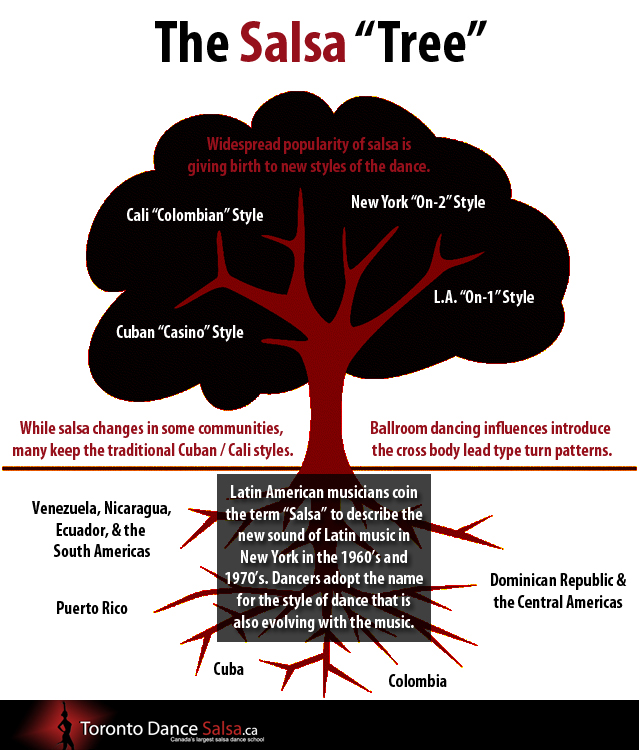Little Known Questions About Dance Fridays.
Wiki Article
Dance Fridays Fundamentals Explained
Table of ContentsEverything about Dance FridaysDance Fridays Can Be Fun For EveryoneAll About Dance FridaysHow Dance Fridays can Save You Time, Stress, and Money.
Let's assume of Salsa dance and songs as an excellent large Tree that looks like this: Salsa is danced globally while numerous technological facets of the dancing coincide throughout styles (6 steps over 8 beats danced on a quick-quick-slow or slow-quick-quick rhythm), there are several "hallmark" functions of the main designs of Salsa that identify one from the various other.Couples getting involved in a Gambling establishment Rueda dance all steps in unison as called by a Leader. Distinguishing features of Cuban style salsa are circular turn patterns (with "break back" actions on matters 1 and 5) as well as body language motivated by traditional Afro-Cuban folkloric dances. Distinguishing attributes of Cali style salsa is quick and complex maneuvering, danced with a solid hand hold connection between companions.
The origins of the style are a topic of debate, but it is claimed that New york city design Salsa dancing came from the 1960's because of the influx of Latin American emigrants after the Cuban Transformation. Eddie Torres is the most well recognized New York design professional dancer, being nearly widely credited with popularizing the design to dance centres outside of New York.
The standard rhythm of "On-2" is slow-quick-quick. The "youngest" of the designs of Salsa, L.A. Design (some people have called it "West Coastline" style) came to be popular in the 1990's and has its origins in ballroom (Mambo, Swing and Cha, Cha, Cha). Transform patterns lead and comply with methods are heavily affected by these styles, with the Cross Body Lead being the keystone of the style.
Things about Dance Fridays
Style are execution of turn patterns and numbers in the "slot", with the break actions on counts "1" and "5". While Salsa music has strong origins in Cuban, Colombian and Puerto-Rican folkoric traditions, it can not be marked down that all Afro-Latin and Latin American cultures have actually added to contemporary Salsa songs as we understand it today.It's possible that due to political reasons the payment of Afro-Cuban culture and heritage to contemporary Salsa in the 1960's and 70's is not extensively acknowledged, however it can not be overlooked the substantial payment and influence of the "Queen of Salsa", Celia Cruz (salsa club san francisco). Thanks to the web and ease of access to details, the appeal of Salsa songs, dancing and culture has spread like wildfire over the last 30 years and even after that modern Salsa artists continue to pay tribute to the Establishing Dads and Mommy of Salsa.
Today Salsa songs is developed, done and well known globally. In 2000 the impact of Latin American music and society (not just Salsa) was recognized by the National Academy of Recording Arts and Sciences in the U.S (https://canvas.instructure.com/eportfolios/2564428/Home/Dance_Fridays_Salsa_Dancing_in_San_Francisco). and the Latin Grammy Awards were produced. The Latin Grammy's have brought interest to the Salsa Legends and contemporary Salsa musicians alike
The Facts About Dance Fridays Uncovered
identifying qualities of Salsa music are: 4/4 measure signature, Child Clave and Tumbao rhythms, Montuno Piano Unless you have a history in music, the above 3 qualities most likely mean nothing to you. A much easier method to describe Salsa songs is how it does NOT seem like other kinds of Latin American preferred music.Bachata is a straight 4 beat dancing with a frequency of a syncopated guitara line and a clear lack of any type of "difficult" piano, brass (trumpet, trombone) lines. Cha, Cha, Cha appears like Salsa music the most as it seems like "truly slow" salsa/mambo. salsa club san francisco. Cha, Cha, Cha can be identified by it's emphasis of the double tumbao beat on counts 4 +5 and 8 +1 (the "cha-cha-cha") You've been to a Salsa night at a club and you're connected you love the music, the power, the look of two dancers sliding throughout the dancing flooring implementing trendy rotates and transform patterns
It's time for lessons. With many studios around and various designs to pick from, where does a full beginner start? Many brand-new professional dancers pick to find out L.A. "On-1" design slotted Salsa styles are one of the most widespread in North America (with some exceptions of some urban centres that still predominantly welcome Cuban and Puerto Rican styles) Website and L (https://salsacrazysf1.bandcamp.com/album/dance-fridays).A
.A. Design will swiftly show you the basics of Salsa timing, weight transfer and turn pattern execution. Many dancers, as soon as they have actually had a year or more of dance L.A. Design Salsa under their belts, "switch" to New York design in order to diversify their dance vocabulary; yet lots of professional dancers make a decision to stay with just one design of Salsa and enjoy their time on the dancing flooring because particular design (salsa club san francisco).
Design and New York City Style all being danced in the very same club, with many of the dancers having the ability to switch over from one design to the various other from one song to the next. No matter which design you choose it's important to stay with that design till you're very comfy with the principles of timing, body rhythm and foundation relocation implementation prior to taking into consideration "changing" styles (if you intend to).

Report this wiki page